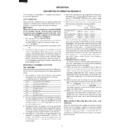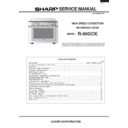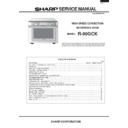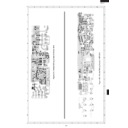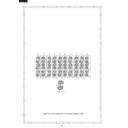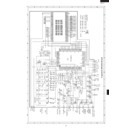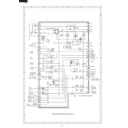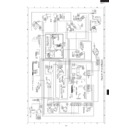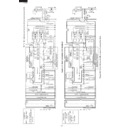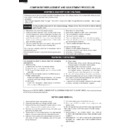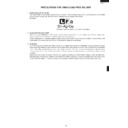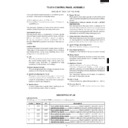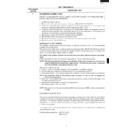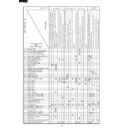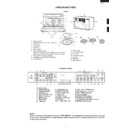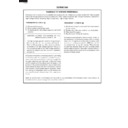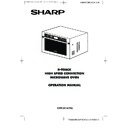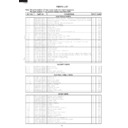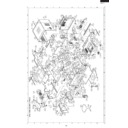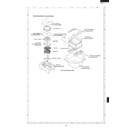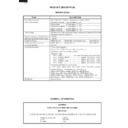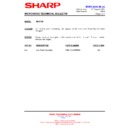Sharp R-90GCK (serv.man5) Service Manual ▷ View online
8
R-90GCK
MAGNETRON TEMPERATURE FUSE.
The temperature fuse located on the waveguide flange is
designed to prevent damage to the magnetron if an over
heated condition develops in the magnetron due to cooling
fan failure, obstructed air guide, dirty or blocked air intake,
etc. Under normal operation, the temperature fuse remains
closed. However, when abnormally high temperatures are
reached within the magnetron, the temperature fuse will
open at 150˚C causing the oven to shut down.
designed to prevent damage to the magnetron if an over
heated condition develops in the magnetron due to cooling
fan failure, obstructed air guide, dirty or blocked air intake,
etc. Under normal operation, the temperature fuse remains
closed. However, when abnormally high temperatures are
reached within the magnetron, the temperature fuse will
open at 150˚C causing the oven to shut down.
TOP HEATER THERMAL CUT-OUT
The thermal cut-out located on the thermal cover upper is
designed to prevent damage to the top heating element
unit if an over heated condition develops in the top heating
element unit due to convection fan failure, thermistor
failure, obstructed air ducts, dirty or blocked air intake, etc.
Under normal operation, the thermal cut-out remains
closed. However, when abnormally high temperature are
reached within the top heating element unit, the thermal
cut-out will open at 170˚C causing the oven to shut down.
When the thermal cut-out has cooled, the thermal cut-out
closes at 155˚C.
designed to prevent damage to the top heating element
unit if an over heated condition develops in the top heating
element unit due to convection fan failure, thermistor
failure, obstructed air ducts, dirty or blocked air intake, etc.
Under normal operation, the thermal cut-out remains
closed. However, when abnormally high temperature are
reached within the top heating element unit, the thermal
cut-out will open at 170˚C causing the oven to shut down.
When the thermal cut-out has cooled, the thermal cut-out
closes at 155˚C.
SIDE HEATER THERMAL CUT-OUT
The thermal cut-out located on the thermal cover left is
designed to prevent damage to the side heating element
unit if an over heated condition develops in the top heating
element unit due to convection fan failure, thermistor
failure, obstructed air ducts, dirty or blocked air intake, etc.
Under normal operation, the thermal cut-out remains
closed. However, when abnormally high temperature are
reached within the side heating element unit, the thermal
cut-out will open at 150˚C causing the oven to shut down.
When the thermal cut-out has cooled, the thermal cut-out
closes at 130˚C.
designed to prevent damage to the side heating element
unit if an over heated condition develops in the top heating
element unit due to convection fan failure, thermistor
failure, obstructed air ducts, dirty or blocked air intake, etc.
Under normal operation, the thermal cut-out remains
closed. However, when abnormally high temperature are
reached within the side heating element unit, the thermal
cut-out will open at 150˚C causing the oven to shut down.
When the thermal cut-out has cooled, the thermal cut-out
closes at 130˚C.
TOP HEATING ELEMENT
The top heating element is located at the top of the oven
cavity. It is intended to heat air driven by the convection
fan. The heated air is kept in the oven and force-circulated
and reheated by the top heating element.
cavity. It is intended to heat air driven by the convection
fan. The heated air is kept in the oven and force-circulated
and reheated by the top heating element.
SIDE HEATING ELEMENT
The side heating element is located at the left side of the
oven cavity. It is intended to heat air driven by the convec-
tion fan. The heated air is kept in the oven and force-
circulated and reheated by the top heating element.
oven cavity. It is intended to heat air driven by the convec-
tion fan. The heated air is kept in the oven and force-
circulated and reheated by the top heating element.
TURNTABLE MOTOR
The turntable motor rotates the turntable located in the
bottom of the oven cavity, so that the food on the turntable
is cooked evenly during cooking. The turntable may turn in
either direction.
bottom of the oven cavity, so that the food on the turntable
is cooked evenly during cooking. The turntable may turn in
either direction.
FAN MOTOR (MAGNETRON SIDE)
The fan motor drives a blade which draws external cool air.
This cool air is directed through the air vents surrounding
the magnetron and cools the magnetron. This air is chan-
nelled through the oven cavity to remove steam and
vapors given off from the heating foods. It is then ex-
hausted through the exhausting air vents at the oven
cavity.
This cool air is directed through the air vents surrounding
the magnetron and cools the magnetron. This air is chan-
nelled through the oven cavity to remove steam and
vapors given off from the heating foods. It is then ex-
hausted through the exhausting air vents at the oven
cavity.
FAN MOTOR (HIGH VOLTAGE TRANSFORMER
SIDE)
SIDE)
The fan motor drives a blade which draws external cool air.
This cool air is directed through the air vents surrounding
the power transformer and cools the power transformer.
This air is channelled through the oven cavity to remove
steam and vapors given off from the heating foods. It is
then exhausted through the exhausting air vents at the
oven cavity.
This cool air is directed through the air vents surrounding
the power transformer and cools the power transformer.
This air is channelled through the oven cavity to remove
steam and vapors given off from the heating foods. It is
then exhausted through the exhausting air vents at the
oven cavity.
CONVECTION COOKING SYSTEM
This oven is designed with a hot air heating system where
food is not directly heated by the heating element, but is
heated by forced circulation of the hot air produced by the
heating elements. The air heated by the heating elements is
circulated through the convection passage provided on the
outer casing of the oven cavity by means of the convection
fan which is driven by the convection motor. It then enters the
inside of the oven through the vent holes provided on the top
and left sides of the oven. Next, the hot air heats the food on
the turntable and leaves the oven cavity through the vent in
the center of the oven cavity back side wall. Without leaving
the oven, this hot air is reheated by the heating elements,
passes through the convection passage and enters the
inside of the oven cavity again, in a continuing cycle. In this
way, the hot air circulates inside the oven cavity to raise its
temperature and, at the same time, comes into contact with
the food being cooked. When the temperature inside the
oven cavity reaches the selected temperature, the heating
elements are de-energized. When the temperature inside
the oven cavity drops below the selected temperature, the
heating elements are energized again. In this way, the inside
of the oven cavity is maintained at approximately the se-
lected temperature. When the convection time reaches 0,
the heating elements are de-energized and the convection
fan stops operating and the oven shuts off.
food is not directly heated by the heating element, but is
heated by forced circulation of the hot air produced by the
heating elements. The air heated by the heating elements is
circulated through the convection passage provided on the
outer casing of the oven cavity by means of the convection
fan which is driven by the convection motor. It then enters the
inside of the oven through the vent holes provided on the top
and left sides of the oven. Next, the hot air heats the food on
the turntable and leaves the oven cavity through the vent in
the center of the oven cavity back side wall. Without leaving
the oven, this hot air is reheated by the heating elements,
passes through the convection passage and enters the
inside of the oven cavity again, in a continuing cycle. In this
way, the hot air circulates inside the oven cavity to raise its
temperature and, at the same time, comes into contact with
the food being cooked. When the temperature inside the
oven cavity reaches the selected temperature, the heating
elements are de-energized. When the temperature inside
the oven cavity drops below the selected temperature, the
heating elements are energized again. In this way, the inside
of the oven cavity is maintained at approximately the se-
lected temperature. When the convection time reaches 0,
the heating elements are de-energized and the convection
fan stops operating and the oven shuts off.
Flow of hot air:
The rotation direction of the convection motor is controlled
by relay RY6. When the convection fan rotates clockwise,
the hot air from the oven cavity left side wall blows stronger
than one from the oven cavity top wall. ( This mode is
called “Convection mode”.) When the convection fan
rotates counterclockwise, the hot air from the oven cavity
top wall blows stronger than one from the oven cavity left
side wall. (This mode is called “JET mode”.)
by relay RY6. When the convection fan rotates clockwise,
the hot air from the oven cavity left side wall blows stronger
than one from the oven cavity top wall. ( This mode is
called “Convection mode”.) When the convection fan
rotates counterclockwise, the hot air from the oven cavity
top wall blows stronger than one from the oven cavity left
side wall. (This mode is called “JET mode”.)
Figure D-2. Rotation direction of convection fan
Side heating
element unit
element unit
Top heating
element unit
element unit
Convection
fan
fan
Convection mode
JET
mode
mode
FRONT VIEW
9
R-90GCK
Figure D-3. Flow of hot air
DAMPER OPEN-CLOSE MECHANISM
Usually, the damper is in the open position except during
convection cooking, preheat, grill, dual1, dual2 or all
cooking modes which use the top / side heating elements.
Damper position is set automatically by damper motor,
damper switch, motor cam and damper shaft. These
components are operated by a signal that judges if
microwave cooking, convection cooking operation or
other cooking operation is selected by the control unit.
convection cooking, preheat, grill, dual1, dual2 or all
cooking modes which use the top / side heating elements.
Damper position is set automatically by damper motor,
damper switch, motor cam and damper shaft. These
components are operated by a signal that judges if
microwave cooking, convection cooking operation or
other cooking operation is selected by the control unit.
Microwave Cooking:
Damper is in the open position, because a portion of cooling
air is channelled through the cavity to remove steam and
vapors given off from the heating foods. It is then exhausted
Damper is in the open position, because a portion of cooling
air is channelled through the cavity to remove steam and
vapors given off from the heating foods. It is then exhausted
Hot air
Hot air
Hot air
Convection
fan
fan
Hot air
Oven cavity left side
Oven cavity
top wall
top wall
Side heating
element unit
element unit
Side heating
element unit
element unit
Top heating element unit Top heating element unit
Turntable
Convection Mode
JET Mode
at the top of the oven cavity into a condensation compart-
ment.
ment.
Convection, Preheat, Grill, Dual1, Dual2, or all cook-
ing modes which use the top / side heating elements:
Damper is in the closed position, so that no hot air will be
allowed to leak out the oven cavity.
ing modes which use the top / side heating elements:
Damper is in the closed position, so that no hot air will be
allowed to leak out the oven cavity.
Damper Operation
1. When power supply cord is plugged in:
1. When power supply cord is plugged in:
1-1. When power supply cord is plugged in, a signal is
sensed in the control unit, and operates shut-off
relay (RY4).
relay (RY4).
1-2. Contacts of shut-off relay (RY4) close, the damper
motor is energized, opening the damper door.
1-3. When the damper is moved to the open position by
the damper cam the damper switch is opened
(OFF position).
(OFF position).
1-4. The signal from damper switch is re-sensed in the
control unit and shut-off relay (RY4) is turned off.
1-5. The rated voltage to the damper motor is removed
and the motor turns off.
2. When oven is microwave cooking:
Damper is in the open position.
3. When oven is convection cooking:
3-1. Damper motor is energized by touching the CONV.
(˚C) and START keys.
3-2. When damper is in the closed position (damper
switch is ON), its signal is sensed by the control
unit, and shut-off relay (RY4) is de-energized.
unit, and shut-off relay (RY4) is de-energized.
3-3. The damper is held in the closed position during
the convection cooking operation.
3-4. At the end of the convection cooking, if the cavity
air temperature is below 121˚C, shut-off relay
(RY4) is energized, and the damper is returned to
the open position.
(RY4) is energized, and the damper is returned to
the open position.
NOTE: If the damper door is not in the proper position,
closed during convection or open during
microwave, the control unit will stop oven
operation after 1 minute.
microwave, the control unit will stop oven
operation after 1 minute.
TROUBLESHOOTING GUIDE
When troubleshooting the microwave oven, it is helpful to
follow the Sequence of Operation in performing the checks.
Many of the possible causes of trouble will require that a
specific test be performed. These tests are given a proce-
dure letter which will be found in the "Test Procedure
"section.
follow the Sequence of Operation in performing the checks.
Many of the possible causes of trouble will require that a
specific test be performed. These tests are given a proce-
dure letter which will be found in the "Test Procedure
"section.
IMPORTANT: If the oven becomes inoperative because
of a blown fuse F10A in the secondary
interlock swith - monitor switch - primary
interlock relay RY2 circuit, check the moni-
tor switch, relay (RY1), primary interlock
relay (RY2) and secondary interlock switch
before replacing the fuse F10A.
interlock swith - monitor switch - primary
interlock relay RY2 circuit, check the moni-
tor switch, relay (RY1), primary interlock
relay (RY2) and secondary interlock switch
before replacing the fuse F10A.
9
R-90GCK
Figure D-3. Flow of hot air
DAMPER OPEN-CLOSE MECHANISM
Usually, the damper is in the open position except during
convection cooking, preheat, grill, dual1, dual2 or all
cooking modes which use the top / side heating elements.
Damper position is set automatically by damper motor,
damper switch, motor cam and damper shaft. These
components are operated by a signal that judges if
microwave cooking, convection cooking operation or
other cooking operation is selected by the control unit.
convection cooking, preheat, grill, dual1, dual2 or all
cooking modes which use the top / side heating elements.
Damper position is set automatically by damper motor,
damper switch, motor cam and damper shaft. These
components are operated by a signal that judges if
microwave cooking, convection cooking operation or
other cooking operation is selected by the control unit.
Microwave Cooking:
Damper is in the open position, because a portion of cooling
air is channelled through the cavity to remove steam and
vapors given off from the heating foods. It is then exhausted
Damper is in the open position, because a portion of cooling
air is channelled through the cavity to remove steam and
vapors given off from the heating foods. It is then exhausted
Hot air
Hot air
Hot air
Convection
fan
fan
Hot air
Oven cavity left side
Oven cavity
top wall
top wall
Side heating
element unit
element unit
Side heating
element unit
element unit
Top heating element unit Top heating element unit
Turntable
Convection Mode
JET Mode
at the top of the oven cavity into a condensation compart-
ment.
ment.
Convection, Preheat, Grill, Dual1, Dual2, or all cook-
ing modes which use the top / side heating elements:
Damper is in the closed position, so that no hot air will be
allowed to leak out the oven cavity.
ing modes which use the top / side heating elements:
Damper is in the closed position, so that no hot air will be
allowed to leak out the oven cavity.
Damper Operation
1. When power supply cord is plugged in:
1. When power supply cord is plugged in:
1-1. When power supply cord is plugged in, a signal is
sensed in the control unit, and operates shut-off
relay (RY4).
relay (RY4).
1-2. Contacts of shut-off relay (RY4) close, the damper
motor is energized, opening the damper door.
1-3. When the damper is moved to the open position by
the damper cam the damper switch is opened
(OFF position).
(OFF position).
1-4. The signal from damper switch is re-sensed in the
control unit and shut-off relay (RY4) is turned off.
1-5. The rated voltage to the damper motor is removed
and the motor turns off.
2. When oven is microwave cooking:
Damper is in the open position.
3. When oven is convection cooking:
3-1. Damper motor is energized by touching the CONV.
(˚C) and START keys.
3-2. When damper is in the closed position (damper
switch is ON), its signal is sensed by the control
unit, and shut-off relay (RY4) is de-energized.
unit, and shut-off relay (RY4) is de-energized.
3-3. The damper is held in the closed position during
the convection cooking operation.
3-4. At the end of the convection cooking, if the cavity
air temperature is below 121˚C, shut-off relay
(RY4) is energized, and the damper is returned to
the open position.
(RY4) is energized, and the damper is returned to
the open position.
NOTE: If the damper door is not in the proper position,
closed during convection or open during
microwave, the control unit will stop oven
operation after 1 minute.
microwave, the control unit will stop oven
operation after 1 minute.
TROUBLESHOOTING GUIDE
When troubleshooting the microwave oven, it is helpful to
follow the Sequence of Operation in performing the checks.
Many of the possible causes of trouble will require that a
specific test be performed. These tests are given a proce-
dure letter which will be found in the "Test Procedure
"section.
follow the Sequence of Operation in performing the checks.
Many of the possible causes of trouble will require that a
specific test be performed. These tests are given a proce-
dure letter which will be found in the "Test Procedure
"section.
IMPORTANT: If the oven becomes inoperative because
of a blown fuse F10A in the secondary
interlock swith - monitor switch - primary
interlock relay RY2 circuit, check the moni-
tor switch, relay (RY1), primary interlock
relay (RY2) and secondary interlock switch
before replacing the fuse F10A.
interlock swith - monitor switch - primary
interlock relay RY2 circuit, check the moni-
tor switch, relay (RY1), primary interlock
relay (RY2) and secondary interlock switch
before replacing the fuse F10A.
9
R-90GCK
Figure D-3. Flow of hot air
DAMPER OPEN-CLOSE MECHANISM
Usually, the damper is in the open position except during
convection cooking, preheat, grill, dual1, dual2 or all
cooking modes which use the top / side heating elements.
Damper position is set automatically by damper motor,
damper switch, motor cam and damper shaft. These
components are operated by a signal that judges if
microwave cooking, convection cooking operation or
other cooking operation is selected by the control unit.
convection cooking, preheat, grill, dual1, dual2 or all
cooking modes which use the top / side heating elements.
Damper position is set automatically by damper motor,
damper switch, motor cam and damper shaft. These
components are operated by a signal that judges if
microwave cooking, convection cooking operation or
other cooking operation is selected by the control unit.
Microwave Cooking:
Damper is in the open position, because a portion of cooling
air is channelled through the cavity to remove steam and
vapors given off from the heating foods. It is then exhausted
Damper is in the open position, because a portion of cooling
air is channelled through the cavity to remove steam and
vapors given off from the heating foods. It is then exhausted
Hot air
Hot air
Hot air
Convection
fan
fan
Hot air
Oven cavity left side
Oven cavity
top wall
top wall
Side heating
element unit
element unit
Side heating
element unit
element unit
Top heating element unit Top heating element unit
Turntable
Convection Mode
JET Mode
at the top of the oven cavity into a condensation compart-
ment.
ment.
Convection, Preheat, Grill, Dual1, Dual2, or all cook-
ing modes which use the top / side heating elements:
Damper is in the closed position, so that no hot air will be
allowed to leak out the oven cavity.
ing modes which use the top / side heating elements:
Damper is in the closed position, so that no hot air will be
allowed to leak out the oven cavity.
Damper Operation
1. When power supply cord is plugged in:
1. When power supply cord is plugged in:
1-1. When power supply cord is plugged in, a signal is
sensed in the control unit, and operates shut-off
relay (RY4).
relay (RY4).
1-2. Contacts of shut-off relay (RY4) close, the damper
motor is energized, opening the damper door.
1-3. When the damper is moved to the open position by
the damper cam the damper switch is opened
(OFF position).
(OFF position).
1-4. The signal from damper switch is re-sensed in the
control unit and shut-off relay (RY4) is turned off.
1-5. The rated voltage to the damper motor is removed
and the motor turns off.
2. When oven is microwave cooking:
Damper is in the open position.
3. When oven is convection cooking:
3-1. Damper motor is energized by touching the CONV.
(˚C) and START keys.
3-2. When damper is in the closed position (damper
switch is ON), its signal is sensed by the control
unit, and shut-off relay (RY4) is de-energized.
unit, and shut-off relay (RY4) is de-energized.
3-3. The damper is held in the closed position during
the convection cooking operation.
3-4. At the end of the convection cooking, if the cavity
air temperature is below 121˚C, shut-off relay
(RY4) is energized, and the damper is returned to
the open position.
(RY4) is energized, and the damper is returned to
the open position.
NOTE: If the damper door is not in the proper position,
closed during convection or open during
microwave, the control unit will stop oven
operation after 1 minute.
microwave, the control unit will stop oven
operation after 1 minute.
TROUBLESHOOTING GUIDE
When troubleshooting the microwave oven, it is helpful to
follow the Sequence of Operation in performing the checks.
Many of the possible causes of trouble will require that a
specific test be performed. These tests are given a proce-
dure letter which will be found in the "Test Procedure
"section.
follow the Sequence of Operation in performing the checks.
Many of the possible causes of trouble will require that a
specific test be performed. These tests are given a proce-
dure letter which will be found in the "Test Procedure
"section.
IMPORTANT: If the oven becomes inoperative because
of a blown fuse F10A in the secondary
interlock swith - monitor switch - primary
interlock relay RY2 circuit, check the moni-
tor switch, relay (RY1), primary interlock
relay (RY2) and secondary interlock switch
before replacing the fuse F10A.
interlock swith - monitor switch - primary
interlock relay RY2 circuit, check the moni-
tor switch, relay (RY1), primary interlock
relay (RY2) and secondary interlock switch
before replacing the fuse F10A.
Display

